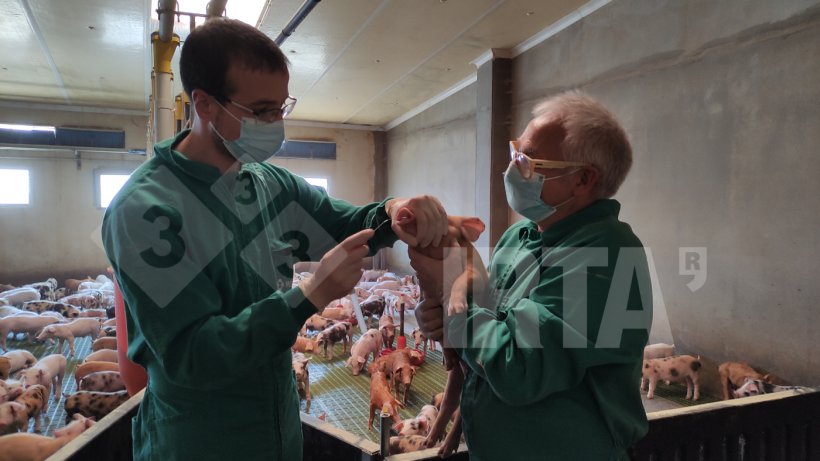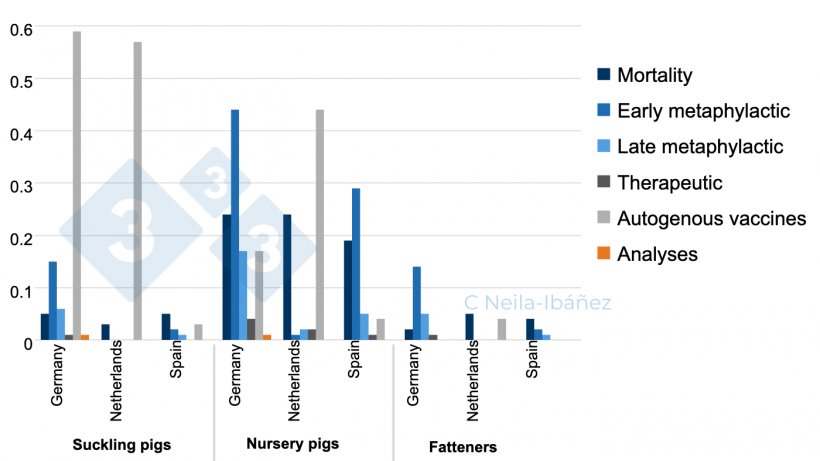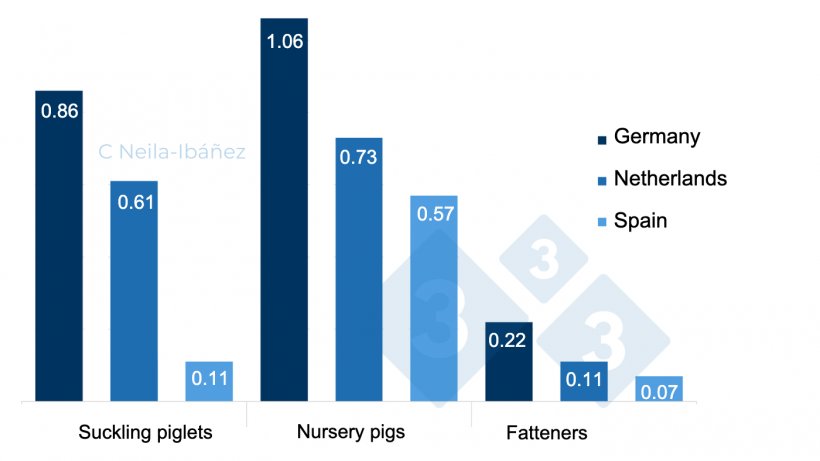Streptococcus suis is an encapsulated Gram‐positive bacterium naturally present in the upper respiratory tract of healthy pigs, that can cause disease in nursery pigs and less frequently in suckling piglets and fattening pigs. The most common clinical signs are meningitis, polyarthritis, and acute death. S. suis is also a zoonotic agent that may cause severe disease in humans, characterized by meningitis, but also sepsis, arthritis, or endocarditis.
Despite S. suis infections being considered a major problem in the swine industry worldwide, there are very few estimations of its economic impact. In this article, we present the main results of a recent study to assess the frequency of disease associated with S. suis infections, as well as the main costs associated with the disease in Germany, the Netherlands, and Spain, three of the main pig-producing countries of Europe.

The majority of the data was obtained through a comprehensive questionnaire, which was administered (throughout 2019) to 33 swine clinical veterinarians (12 in Spain, 11 in the Netherlands, and 10 in Germany) aimed to be representative of the different types of pig production present in the areas of study. The questionnaire included questions related to the number of farms of which they were in charge and the proportions of farms, batches, and animals that were clinically affected in the last year in the different production phases, as well as the treatments applied. The cost of disease calculated included the losses directly caused by the disease, and the expenditures as a result of antimicrobial treatments, autogenous vaccines and laboratory analyses. Indirect costs such as the effect on public health or the reduction of the access to better markets were not considered.

Frequency of disease
The clinical veterinarians interviewed provided data from 1,652 production units in Germany, 480 in the Netherlands and 1,583 in Spain (Table 1). In the three countries, nursery was the phase with the highest proportions of units affected (62.0 to 82.9% depending on the country) and batches within those units affected (64.1 to 66.5%). The incidence of S. suis-associated disease in nursery pigs in the countries of study ranged from 3.3 to 4.0%, with a mortality between 0.5 and 0.9%. The proportion of farms with suckling piglets with S. suis-associated disease was similar, but the number of batches and animals affected were lower than in nurseries (Table 1).
Table 1: Frequency of S. suis-associated disease in the countries of study.
| Phase | Country | Total units | Mean number of animals produced per year | % of units clinically affected | % of batches clinically affected within affected units | % of animlas with S. suis disease | Mortality (%) caused by S. suis disease |
|---|---|---|---|---|---|---|---|
| Suckling piglets | Germany | 510 | 10,725 | 64.5% | 52.9% | 2.2% | 0.4% |
| Netherlands | 157 | 17,614 | 66.7% | 43.3% | 1.6% | 0.3% | |
| Spain | 437 | 25,780 | 80.4% | 36.1% | 1.2% | 0.4% | |
| Nursery Pigs | Germany | 468 | 10,620 | 62.0% | 64.1% | 3.3% | 0.5% |
| Netherlands | 171 | 16,423 | 68.0% | 65.2% | 4.0% | 0.9% | |
| Spain | 370 | 22,665 | 82.9% | 66.5% | 3.3% | 0.7% | |
| Fatteners | Germany | 674 | 8,173 | 39.8% | 19.8% | 0.2% | 0.0% |
| Netherlands | 152 | 9,119 | 58.2% | 28.3% | 0.3% | 0.1% | |
| Spain | 776 | 7,774 | 47.1% | 31.8% | 0.3% | 0.1% |
Cost per animal
Despite the similar frequencies of disease, the mean total costs were very different between the three countries. The cost per suckling piglet in affected farrowing units ranged from 0.86 euros in Germany to 0.11 in Spain. In affected nursery units, the costs per animal were higher, (between 1.06 and 0.57 euros), while in affected fattening units, the costs were much lower (between 0.22 and 0.07 euros per fattener).
Types of costs
The mortality losses per nursery pig ranged from 0.19 euros in Spain to 0.24 in Germany and the Netherlands, while values for suckling piglets and fatteners were much lower (Figure 2). Weight losses due to S. suis infection were considered negligible in the three phases. Substantial differences were observed between countries and phases in the expenditure of early metaphylactic treatments (Figure 1 and 2), that is, the antimicrobial treatment applied to healthy animals in farms endemically affected by S. suis disease. The highest expenditures were in Germany, in particular in nursery pigs (0.44 euros per animal), but also in suckling piglets (0.15 euros) and fatteners (0.14 euros) (Figure 2). In Spain, the expenditure of early metaphylaxis was important only in nursery pigs (0.29 euros per animal), while in the Netherlands it was almost negligible in all phases (Figure 2). The expenditure of the antimicrobial treatment applied to both healthy and sick animals, when the disease appears, called late metaphylactic treatment in the study, was consistently low, except for nursery pigs in Germany (0.17 euros per animal) (Figure 1).
There were important differences between countries in relation to the expenditure on autogenous vaccines. The costs of vaccination of sows (included in the costs of suckling piglets) were high in Germany and in the Netherlands (0.59 and 0.57 euros per piglet, respectively) (Figure 2). The cost in nursery pigs in the Netherlands was also high (0.44 euros, Figure 2). In contrast, in Spain, spending on autogenous vaccines was low in all phases (Figure 2). There were even substantial differences in the expenditure on autogenous vaccines within a country. Finally, the costs of laboratory analyses were almost negligible in all the countries.


The average cost of S. suis for each pig produced in the country (i.e. considering the costs in the different phases and the frequencies of disease) was 1.30 euros in Germany, 0.96 in the Netherlands, and 0.60 in Spain. Those differences in costs between countries can be explained to a great extent by the measures to control S. suis implemented in each country. It is worth mentioning that, at the time of data collection, the legislation on the use of antimicrobials in the studied countries was different. Whereas in Germany early metaphylaxis was only justifiable in exceptional cases and the late metaphylactic antimicrobial treatment was allowed, in the Netherlands the early metaphylactic treatment was forbidden and late metaphylaxis was allowed. In contrast, in Spain early and late metaphylaxis treatment were not forbidden by law. The data from the study show that use of antimicrobials, predominantly beta-lactams, is still crucial for the control of the disease in Spain and in Germany; while in Germany and the Netherlands a significant part of the cost of S. suis is due to the expenditure on autogenous vaccines.





